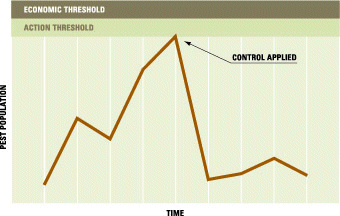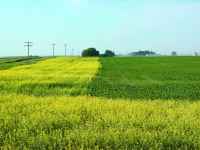| | Integrated Pest Management | Pesticide Application
Integrated Pest Management
Crop pests include plants, insects, birds, mammals and diseases that reduce crop yield and/or quality. Integrated pest management (IPM) involves using a combination of control methods (cultural, biological, chemical and mechanical) in a program that is both economically and environmentally sound. IPM considers the overall management of a pest species, not just the control measures used during destructive outbreaks. The objective of IPM is to prevent pest outbreaks.
This pest management system offers a variety of advantages compared to using a single management tool to control a pest including:
- fewer pesticide applications, resulting in more efficient use of inputs such as pesticides, fuel, water and time.
- less potential impact on soil, water and non-target species of fish, wildlife and insects.
- more stability in the pest complex with the potential of fewer emerging problems because competitors and beneficial species are not eliminated.
- no loss of quality or yield in the long term.
However, IPM presents some challenges. It requires a greater understanding and long-term commitment on the part of farmers. Farmers must be willing to keep up to date with research findings and monitoring techniques, and keep complete records. On some crops, IPM principles require a more complete, longer-term focus to make economic sense. There may be some added expenses for monitoring equipment, field scouting and consultants. And IPM programs are not always easily transferred from area to area because of variations in climates and pest complexes.
IPM has four basic steps:
| 1. | Identify the pest and use pest control methods that focus on prevention of outbreaks. |
| 2. | Monitor pest and beneficial species populations, and use economic thresholds (Figure 3.9) for implementing control measures. |
| 3. | Choose control options, implement them when thresholds indicate control is needed, and assess their effectiveness. |
| 4 | Keep records of all pertinent data and results. |

Figure 3.9 .Threshold levels for pest control
Adapted from: Agriculture and Agri-Food Canada. 2000. Pest Management and Water Quality. Water Quality Matters Factsheet Series.
Threshold identification -Two pest threshold levels are identified in an IPM system. The first is the economic threshold, which occurs when pest density causes damage equal to the cost of control measures. The second is the action threshold, which is defined as the pest density when control measures should be applied. The action threshold is lower than the economic threshold to allow time for treatment to take effect.
Pest Control Methods
Cultural control:
- Manage the crop for a vigorous, healthy stand that is better able to withstand pests.
- Choose pest-resistant varieties.
- Use rotations to reduce or eliminate the conditions the pest needs to thrive.
- Varying planting and harvest dates can help to prevent certain pest problems.
- Eliminate materials or places where pests live and reproduce by:
- purchasing clean, treated seed.
- cleaning all tillage, seeding and harvesting equipment between fields.
- removing contaminated crop residue.
- removing nearby plant species that can act as alternate hosts for diseases or insects.
- Use trap strips to draw the pest's attention away from the crop (see box).
- If possible, leave strips of a forage or hay crop standing when harvesting (called strip harvesting). This will prevent the migration of pests to another field, preserve natural enemies of pests and improve snow management.
Biological control:
- Use an introduced agent (insect, pathogen) to control the pest.
- Introduced pest has to be established in sufficient numbers to be effective.
- Avoid pesticides that will kill the introduced agent.
Mechanical control:
- Mowing, tilling, grazing and hand pulling can be used to control weeds.
- Silage weedy fields to stop the weeds from going to seed.
Chemical control:
- Select and apply pesticides according to label instructions to minimize harmful effects on non-target species and to reduce environmental hazards (see Pesticide Application).
Trap strips -Trap strips are strips of crops grown around the main crop to draw insects away from the main crop. The pest can be more easily controlled while it is contained in a concentrated strip.
Typically the timing of the trap crop's growth cycle is somewhat different from that of the main crop. For example, a strip of Polish canola can be seeded around the outside of an Argentine canola crop to control cabbage seedpod weevils. Polish canola blooms earlier so its flowers attract the weevils to the trap strip.
- For more information, see Integrated Pest Management in Canada: A Directory of Expertise (AAFC), Natural Enemies of Pests Associated with Prairie Crops (AAFC) and Using Cultural Practices to Reduce Pest Problems in Crops (ARD).

Trap strips draw insects away from the main crop.
Courtesy of Agriculture and Agri-Food Canada, Lethbridge
Pesticide Application
Producers have the legal right to apply pesticides on their property provided that the pesticide application does not contravene any bylaws, regulations or generally accepted practices.
Producers have the legal responsibility to ensure that any pesticide application performed on their property does not cause harm to adjacent properties or people. When using custom applicators, ensure that applicators are certified. Also ensure that the applicator is aware of potential hazards in advance of an application.
If pesticides are part of your integrated pest management plan, follow these practices:
Deciding if pesticides are needed
- Use timely and regular field scouting to accurately assess your pest problems and to assess economic threshold levels, so you can apply pesticides only when they are needed.
Determining application rates
- Apply pesticides according to the label instructions. Avoid overapplication.
Selecting pesticides
- Do not use persistent herbicides on flood-prone or sandy soils.
- Rotate chemical groups to prevent the development of resistant pest populations.
Minimizing transport of pesticides off the field
- Reduce movement of pesticides attached to soil particles through measures that control wind and water soil erosion such as maintaining a crop residue cover, growing shelterbelts and establishing grassed waterways (Table 3.5).
- Leave wide buffer zones around environmentally sensitive areas, including streams, rivers, wells and dugouts. As a minimum, these zones should meet all buffer width regulations.
- Avoid irrigating soon after a pesticide application. Check the product label for details.
- Avoid applying pesticides if rain is expected soon.
- Do not wash spray equipment in a water body or move this equipment through a water body.
Table 3.5. Loss potentials of some common agricultural chemicals
| Pesticide | Runoff Potential | Leaching Potential |
| Banvel | Small | Large |
| Basagran | Small | Medium |
| 2,4-D Amine | Medium | Medium |
| Lexone, Sencor | Medium | Large |
| Linuron | Large | Medium |
| Poast | Small | Small |
| Roundup | Large | Small |
| Treflan | Large | Small |
| Counter | Medium | Small |
| Dyfonate | Large | Medium |
| Bayleton | Medium | Medium |
| Tilt | Medium | Medium |
* Runoff potential: potential for transport of pesticide in runoff water.
Source: Agriculture and Agri-Food Canada and Ontario Ministry of Agriculture and Food. 1992. Best Management Practices: Field Crop Production. Agriculture and Agri-Food Canada, and Ontario Ministry of Agriculture and Food.
Reducing spray drift
- Reduce sprayer travel speed, lower the boom, use shrouds and/or use a properly adjusted air assist to reduce the risk of spray drift.
- Increase droplet size to reduce spray drift. Use spray nozzles that deliver a larger droplet size, lower the spray boom, and avoid spraying in high temperatures or low relative humidity.
- Create less drift-prone sprays by reducing pressure, increasing carrier volume, using low drift nozzles or using a drift-reducing adjuvant.
- Stop application when wind speeds are above 16 to 20 km/h.
- Check pesticide labels for wind speed limits to avoid spray drift.
- If you must spray near environmentally sensitive areas, such as water sources, neighbours' yards and shelterbelts, spray when the wind is blowing away from them.
- Use a buffer zone to capture the major portion of drifted droplets to minimize risk to adjacent areas.
- Avoid spraying during a temperature inversion (see Pesticide Drift).
- Avoid spraying volatile products on or just before hot days to decrease vapour drift.
Reduce spray drift damage by using low drift nozzles or using a drift-reducing adjuvant.
Courtesy of Agriculture and Agri-Food Canada - Tom Wolf and AgTech Centre - ARD
Back to Chapter 3 - Cropping Practices |
|